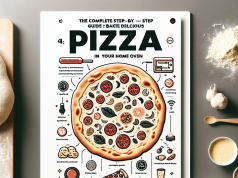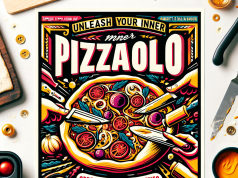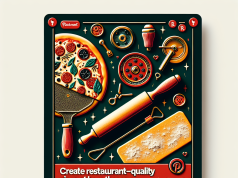<h2>Crust on a Budget: Master Homemade Pizza Without a Pizza Stone</h2>
<p>Are you eager to create delicious homemade pizza but reluctant to invest in expensive kitchenware? You’re in luck! In this guide, we will show you how to master the **art of pizza-making** without a **pizza stone**. Learn to whip up your own **tasty pizza crust** using wallet-friendly ingredients and everyday kitchen tools. Get ready to impress your friends and family with your newfound skills, all while sticking to your budget!</p>
<article>
<h2>Understanding Pizza Crust</h2>
<p>The foundation of any great pizza is the **crust**. Mastering the **pizza crust** can elevate your homemade pizza without the need for expensive equipment like a pizza stone.</p>
<h3>Types of Pizza Crust</h3>
<ul>
<li><strong>Thin Crust:</strong> Crispy and easy to handle, perfect for classic pizzas.</li>
<li><strong>Thick Crust:</strong> Chewy and satisfying, great for deep-dish styles.</li>
<li><strong>Sourdough Crust:</strong> A tangy flavor that requires a bit more time for fermentation.</li>
</ul>
<h2>Ingredients for Homemade Pizza Crust</h2>
<p>Creating your own **pizza crust** at home involves simple ingredients:</p>
<ul>
<li>2 cups of all-purpose flour</li>
<li>1 teaspoon of salt</li>
<li>1 teaspoon of sugar</li>
<li>1 packet (2 1/4 teaspoons) of active dry yeast</li>
<li>3/4 cup of warm water</li>
<li>2 tablespoons of olive oil</li>
</ul>
<h2>Steps to Make Pizza Crust Without a Pizza Stone</h2>
<h3>1. Prepare the Dough</h3>
<p>
- In a bowl, combine warm water, yeast, and sugar. Let it sit for about 5 minutes.<br>
- Mix flour and salt in a separate bowl. Gradually add the yeast mixture and stir until combined. Knead for about 5-10 minutes until smooth.
</p>
<h3>2. Let it Rise</h3>
<p>Cover the dough with a damp cloth and let it rise in a warm area for about 1 hour, or until it doubles in size.</p>
<h3>3. Preheat the Oven</h3>
<p>Preheat your oven to 475°F (245°C) while the dough is rising. A hot oven helps achieve a crispy crust.</p>
<h3>4. Shape the Crust</h3>
<p>Once the dough has risen, punch it down and roll it out on a lightly floured surface. Shape it into your desired size and thickness.</p>
<h3>5. Baking the Pizza</h3>
<p>Instead of a pizza stone, use a preheated baking sheet or a cast-iron skillet. Transfer the dough to the hot surface, add your favorite toppings, and bake for about 12-15 minutes or until golden brown.</p>
<h2>Tips for Perfecting Your Homemade Crust</h2>
<ul>
<li><strong>Experiment with Flour:</strong> Try bread flour for a chewier texture.</li>
<li><strong>Use Cornmeal:</strong> Sprinkle cornmeal on your baking surface to prevent sticking and add crunch.</li>
<li><strong>Pre-Bake the Crust:</strong> If you prefer a crunchier crust, pre-bake for 5 minutes before adding toppings.</li>
</ul>
<h2>Popular Toppings for Your Pizza</h2>
<p>Once you’ve mastered the **crust**, it’s time to get creative with toppings:</p>
<ul>
<li>Classic Marinara Sauce & Mozzarella Cheese</li>
<li>Pesto & Goat Cheese</li>
<li>BBQ Sauce, Chicken & Cilantro</li>
<li>Rich Tomato & Veggie Medley</li>
</ul>
<h2>Resources for Further Learning</h2>
<p>For more tips on homemade pizza, check out <a href="https://www.seriouseats.com/pizza" target="_blank">Serious Eats: Pizza</a>.</p>
</article>
Contents
FAQs: Crust on a Budget – Master Homemade Pizza Without a Pizza Stone
1. Can I make pizza without a pizza stone?
Yes! You can achieve great results using a baking sheet, cast iron skillet, or even a regular oven rack. These alternatives can help you create a crispy crust without the need for a pizza stone.
2. What type of dough works best for homemade pizza?
A simple bread dough works well for homemade pizza. You can use all-purpose flour, water, yeast, and salt to make a quick and easy dough. For added flavor, consider using olive oil and herbs.
3. How can I get a crispy crust without a pizza stone?
To achieve a crispy crust, preheat your oven to its highest temperature. Use a preheated baking sheet or cast iron skillet to bake your pizza. Also, avoid using too much sauce and toppings, which can make the crust soggy.
4. What temperature should I bake my pizza at?
For the best results, preheat your oven to around 475°F (245°C). Baking at a high temperature helps to crisp the crust more effectively.
5. How long should I bake my pizza?
Typically, homemade pizza takes about 10-15 minutes to bake, depending on your oven and the thickness of the crust. Keep an eye on it and remove it once the cheese is bubbly and golden brown.
6. Can I make pizza dough in advance?
Yes! Pizza dough can be made in advance and stored in the refrigerator for 1-2 days, or you can freeze it for up to 3 months. Just remember to let it come to room temperature before shaping it into a crust.
7. What toppings can I use for a budget pizza?
Stick to budget-friendly toppings like mozzarella cheese, pepperoni, bell peppers, onions, and mushrooms. Seasonal vegetables or leftover cooked meats can also be great additions without breaking the bank.
Choosing the Right Baking Surface
One of the key tips for making homemade pizza without a pizza stone is selecting an appropriate baking surface. You can use a thick baking sheet, a cast iron skillet, or even a preheated pan to achieve a crispy crust.
Using a Baking Sheet
When using a baking sheet, preheat it in the oven to achieve a better crust. Consider using parchment paper to prevent sticking, and be sure to dust it with flour or cornmeal.
Cast Iron Skillet Advantage
A cast iron skillet is an excellent alternative as it retains heat well. Preheat the skillet in the oven, then add your pizza dough directly to it for an evenly cooked dish.
Preparing the Dough
The dough is the foundation of your pizza. Aim for a high hydration dough mix to ensure a lighter and airier crust. Letting it rise sufficiently will enhance the flavor and texture.
Incorporating Flavor
Experiment with seasoning the dough. Adding herbs and garlic can elevate the taste, giving your crust a unique flavor profile.
Resting Time
Allow the dough to rest after kneading; this aids gluten development, resulting in better elasticity and shape retention while baking.
Baking Techniques
Proper baking techniques can significantly improve your homemade pizza. Preheat your oven to the highest setting to mimic a pizza oven-like environment.
Utilizing a Broiler
For an extra crispy top, switch on the broiler for the last few minutes of baking. This creates an environment similar to that of a traditional pizza oven.
Monitoring Cooking Time
Keep a close eye on your pizza while it’s baking. Every oven is different, and factors like thickness and toppings can affect baking time. Aim for a golden brown crust and bubbling cheese.
For more details on pizza making, check out the Wikipedia page on pizza.
Summary of “Crust on a Budget”
- Master homemade pizza without needing a pizza stone.
- Emphasizes budget-friendly tips and ingredients.
- Focus on achieving a crispy crust using alternative methods.
- Explains the importance of oven temperature and baking techniques.
- Offers various topping suggestions for creativity.
- Includes step-by-step instructions for making dough from scratch.
- Shares practical advice for kitchen equipment substitutions.
Key Techniques
- Use a cast-iron skillet or baking sheet for effective baking.
- Preheat the oven to achieve a pizzeria-quality crust.
- Allow dough to rise adequately for better texture.
Budget-Friendly Tips
- Utilize pantry staples for pizza ingredients.
- DIY sauce and cheese options to save money.
- Batch make dough to use on future pizza nights.








































